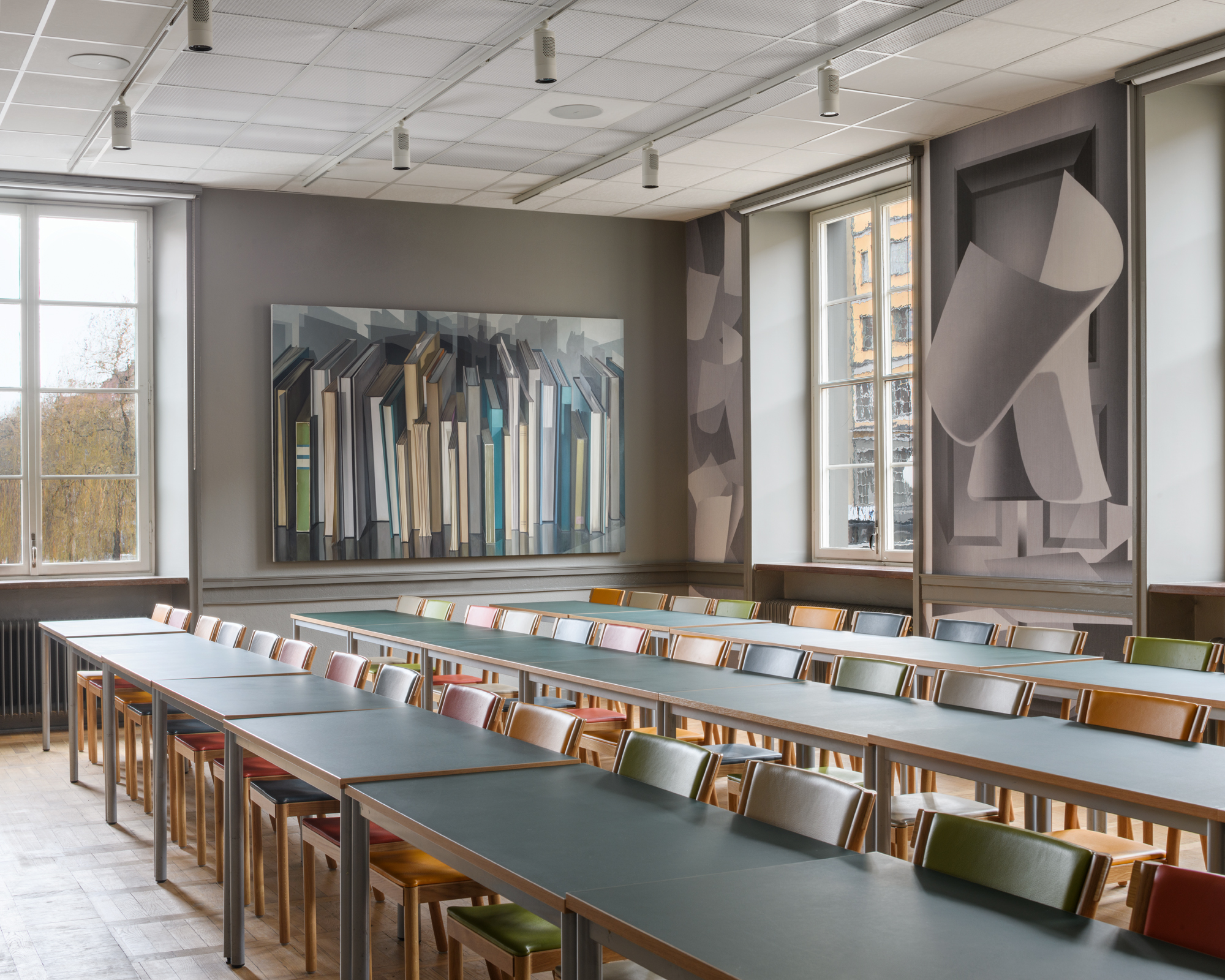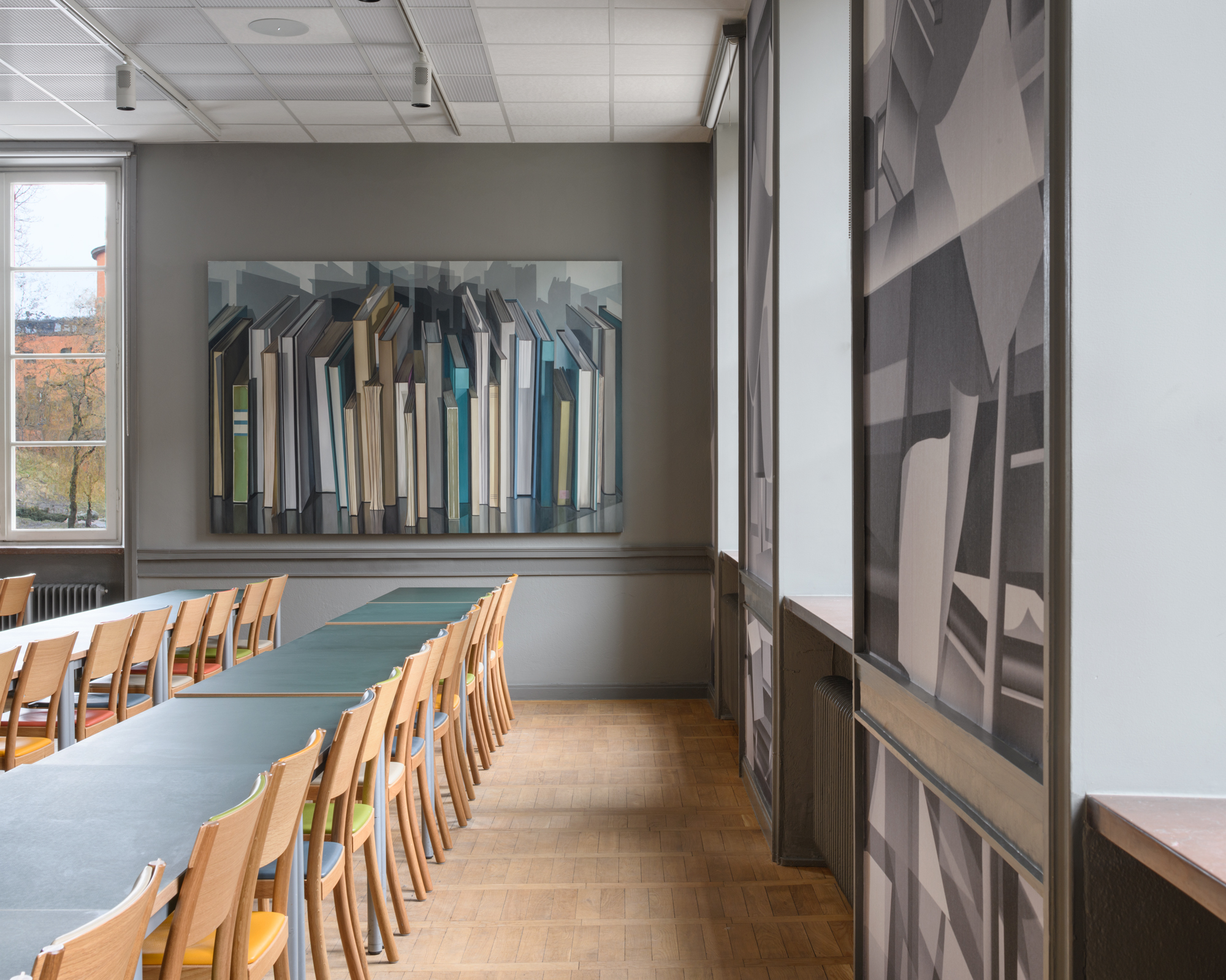The Schumpeter Room by Carl Hammoud

The work Carl Hammoud has made for this room comprises six new paintings, a site specific digital painting printed on linen wallpaper – and a choice of materials and complete color coordination of all walls and furniture.
Carl Hammoud is a Swedish artist born in 1976, living and working in Stockholm, Sweden. He has exhibited in galleries and museums in Europe, Asia and USA, and was educated at Valand Academy in Gothenburg. He primarily works as a painter, and many of his paintings depict interior environments such as offices and libraries.
The room was made possible thanks to a generous donation by Henrik and Anine Ekelund.
All photos of the room are by Mikael Olsson
Schumpeter, innovation and entrepreneurship by Henrik Ekelund
Joseph Schumpeter (1883–1950) was an Austrian economist that gave us groundbreaking new concepts of economic growth, innovation and entrepreneurship. To put his work into perspective; after Adam Smith's foundational work at the end of the 1700s, which included an optimistic view of the prospect of economic growth in nations, three growth pessimists took a lot of space during the 1800s – Thomas Malthus, David Ricardo and Karl Marx. They all believed that economic growth would not be sustainable in the long term, basically due to the law of diminishing returns – resources would dwindle, population grow faster than output, returns on investments decline. Joseph Schumpeter added the piece that the growth pessimists had missed.
The missing piece of the pessimists' theories was innovation. Very simply, if innovation made humans and machines more efficient, the law of diminishing return would be altered, and the theories of Malthus, Ricardo and Marx would not hold.
In his famous book “Capitalism, Socialism and Democracy” first published in 1942 he introduced the concept of “creative destruction” as key to sustainable economic growth. Most economists before Schumpeter – as well as many after him – focused on the economic equilibrium, a state of full employment and economic balance. Schumpeter's view was that an economic balance and a steady state was far from the real world and nothing to strive for. Economic growth and progress were not peaceful and gradual; instead based on continuous disruptions of the old order, where existing businesses and workers for some time could experience big losses and be replaced by a new order.
“The same process of industrial mutation – if I may use a biological term – that incessantly revolutionizes the economic structures from within, incessantly destroying the old one, incessantly creating a new one”, he wrote.
Schumpeter's theory of long-term economic growth focused on three driving factors – growth of productive factors (labor and capital), innovation and an investment friendly society. Joseph Schumpeter was also the first economics scholar to describe the vital role of the entrepreneur to create growth.
In order to achieve progress and growth, we need to use our resources - people, capital, land, technology, and know how - in new and better ways. This development does not happen by itself. Who will take initiative? Who will find the opportunities? Who kicks off and leads the major changes needed to create innovation? Enter the entrepreneurs. They act as the catalysts in the process of economic development. Natural resources and technical progress alone do not lead to economic development. Entrepreneurs put the pieces together, build organizations and take innovations to market.
Schumpeter's view was that the ability to build businesses and make innovations happen in a risky and uncertain world demands exceptional abilities. Therefore, the entrepreneurs have a critical role.
Schumpeter writes “The entrepreneur in an advanced economy is an individual who introduces something new in the economy, a method of production not yet tested by experience in the branch of manufacture concerned, a product with which consumers are not yet familiar, a new source of raw-material or of new markets and the like…….Entrepreneurship, as defined, essentially consists in doing things that are not generally done in the ordinary course of business routine”.
What is an entrepreneur? Joseph Schumpeter, used the following description:
“Whatever the type, everyone is an entrepreneur only when he actually carries out new combinations and loses that character as soon as he has built up his business, when he settles down to running it as other people run their business”.
Text by Henrik Ekelund
A metaphor for the complexities of life by Anine Ekelund
As you step into the Schumpeter room and gaze upon the captivating artwork by the renowned Swedish artist, Hammoud, depicting papers swirling and dancing through the air, it serves as a visual metaphor for the complexities of life. Just as these papers seem to float in a state of chaos, you may sometimes find your own life filled with the whirlwind of academic pursuits, personal aspirations, and intricate interpersonal dynamics.
The artwork's depiction of chaos resonates with the innovative spirit of Joseph Schumpeter, the Austrian economist whose groundbreaking ideas from the early 1940s continue to shape our understanding of economic growth, innovation, and entrepreneurship. Schumpeter himself recognized that within chaos lies the potential for transformative change. It's in the midst of uncertainty and disruption that the seeds of innovation are often sown, and the most brilliant ideas take root.
Embracing the chaos in your life is a valuable skill. Just as Schumpeter's ideas revolutionized economics, your ability to navigate and find inspiration within chaos can lead to your own groundbreaking discoveries and personal growth. Remember that out of chaos, the best ideas often emerge, and when you trust in the process, things have a way of sorting themselves out to yield the best results in the end.
So, as you embark on your journey in this room dedicated to the legacy of Schumpeter, let the artwork by Hammoud and the wisdom of Schumpeter himself remind you that chaos is not an obstacle but an opportunity. Embrace it, harness it, and watch as it propels you towards your own path of innovation and success, both within these classroom walls and in the broader canvas of life.
- text by Anine Ekelund

